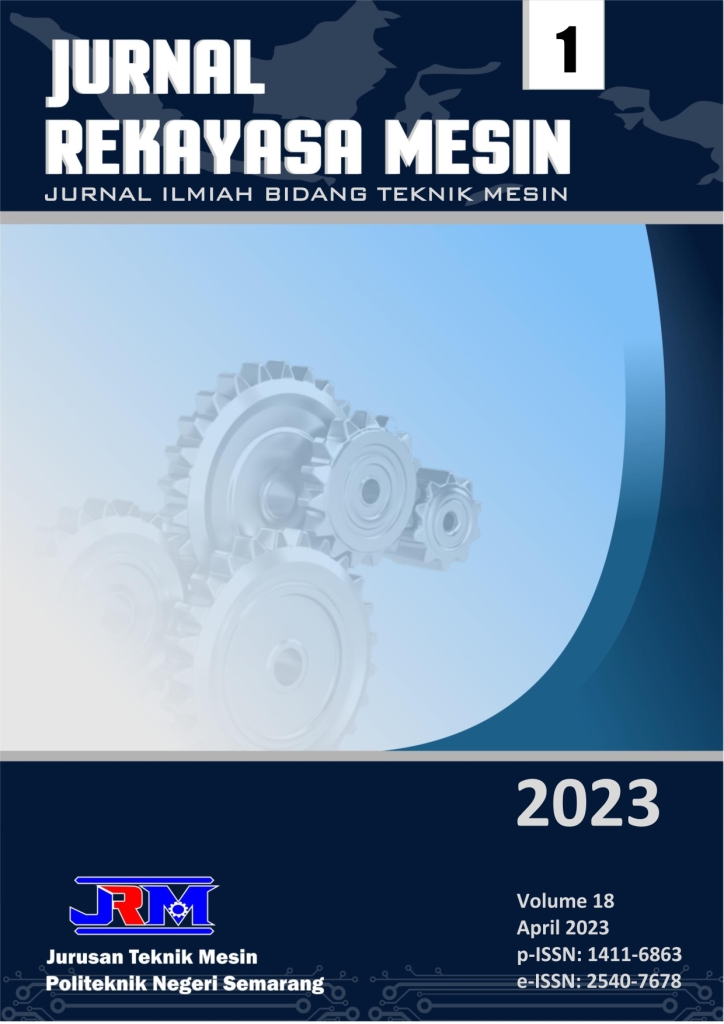Desain dan Analisis Elemen Hingga Model Wrist Hand Orthosis Berbasis Metode Pemodelan Reverse Engineering
DOI:
https://doi.org/10.32497/jrm.v18i1.3936Keywords:
finite element analysis, reverse engineering, wrist-hand orthosisAbstract
Salah satu treatment untuk spasticity efek pasca stroke, fracture karena kecelakaan, injury karena cedera olahraga, dan musculoskeletal disorders karena pekerjaan kantoran pada pergelangan tangan selain dengan operasi yaitu dengan penggunaan wrist hand orthosis. Umumnya pembuatan medical device tersebut menggunakan metode konvensional yang mempunyai kekurangan. Hadirnya teknologi reverse engineering (RE) dapat diaplikasikan dalam bidang medis seperti pembuatan alat prosthetic atau orthosis. Pada penelitian ini bertujuan untuk mengembangkan desain wrist hand orthosis berbasis reverse engineering dan menganalisisnya menggunakan metode elemen hingga. Metode penelitian meliputi 3D scanning, CAD modelling, model analysis, dan post processing. Material model yang digunakan adalah ABS dengan variasi ketebalan 5 mm, 6 mm, dan 7 mm, serta besar nilai pembebanan mulai dari 5 N sampai 25 N. Hasil analisis equivalent stress menunjukkan model ketebalan 5 mm mampu menahan load 25 N dengan maximum equivalent stress sebesar 13.52 MPa yang masih tergolong aman dengan nilai safety factor 2.11 dengan area kritis di ujung punggung telapak tangan model antara ibu jari dan jari telunjuk. Hasil equivalent elastic strain dan deformation juga mempunyai tren grafik yang sama dengan nilai maximum pada model ketebalan 5 mm yaitu masing-masing sebesar 0.0057 mm dan 0.616 mm. Dari hasil analisis tersebut dapat disimpulkan bahwa model wrist hand orthosis berlubang voronoi yang memiliki bentuk seperti surface tangan manusia dengan ketebalan minimalis 5 mm mampu bekerja dengan baik memfiksasi tangan pasien untuk proses rehabilitasi.References
H. Hsu, M. P. Fahrenkopf, and S. V Nallamothu, “Wrist fracture,” StatPearls [Internet], 2021.
M. S. Sirajudeen, M. Alaidarous, M. Waly, and M. Alqahtani, “Work-related musculoskeletal disorders among faculty members of college of Applied Medical Sciences, Majmaah University, Saudi Arabia: A cross-sectional study,” Int. J. Health Sci. (Qassim)., vol. 12, no. 4, p. 18, 2018.
M. Calbiyik, “Fixation of unstable distal radius fractures by using expandable Intramedullary nailing system in adult patients,” Pakistan J. Med. Sci., vol. 34, no. 1, p. 198, 2018.
Y. K. Modi, “Calcium sulphate based 3D printed tooling for vacuum forming of medical devices: an experimental evaluation,” Mater. Technol., vol. 33, no. 10, pp. 642”“650, 2018.
J. L. Keller, J. P. Henderson, K. W. Landrieu, M. P. Dimick, and J. M. Walsh, “The 2019 practice analysis of hand therapy and the use of orthoses by certified hand therapists,” J. Hand Ther., 2021.
D. Palousek, J. Rosicky, D. Koutny, P. Stoklásek, and T. Navrat, “Pilot study of the wrist orthosis design process,” Rapid Prototyp. J., 2014.
Y. Zheng et al., “Effects of a 3D-printed orthosis compared to a low-temperature thermoplastic plate orthosis on wrist flexor spasticity in chronic hemiparetic stroke patients: a randomized controlled trial,” Clin. Rehabil., vol. 34, no. 2, pp. 194”“204, 2020.
H. Kim and S. Jeong, “Case study: Hybrid model for the customized wrist orthosis using 3D printing,” J. Mech. Sci. Technol., vol. 29, no. 12, pp. 5151”“5156, 2015.
G. Baronio, S. Harran, and A. Signoroni, “A critical analysis of a hand orthosis reverse engineering and 3D printing process,” Appl. bionics Biomech., vol. 2016, 2016.
S. J. Kim, S. J. Kim, Y. H. Cha, K. H. Lee, and J.-Y. Kwon, “Effect of personalized wrist orthosis for wrist pain with three-dimensional scanning and printing technique: a preliminary, randomized, controlled, open-label study,” Prosthet. Orthot. Int., vol. 42, no. 6, pp. 636”“643, 2018.
F. Górski, W. Kuczko, W. Weiss, R. Wichniarek, and M. Å»ukowska, “Prototyping of an Individualized Multi-Material Wrist Orthosis using Fused Deposition Modelling,” Adv. Sci. Technol. Res. J., vol. 13, no. 4, 2019.
Y. K. Modi and N. Khare, “Patient-specific polyamide wrist splint using reverse engineering and selective laser sintering,” Mater. Technol., vol. 37, no. 2, pp. 71”“78, 2022.
L. Sutton, H. Moein, A. Rafiee, J. D. W. Madden, and C. Menon, “Design of an assistive wrist orthosis using conductive nylon actuators,” in 2016 6th IEEE International Conference on Biomedical Robotics and Biomechatronics (BioRob), 2016, pp. 1074”“1079.
S. Ates, I. Mora-Moreno, M. Wessels, and A. H. A. Stienen, “Combined active wrist and hand orthosis for home use: Lessons learned,” in 2015 IEEE International Conference on Rehabilitation Robotics (ICORR), 2015, pp. 398”“403.
H. Dodziuk, “Applications of 3D printing in healthcare,” Kardiochirurgia i torakochirurgia Pol. Polish J. cardio-thoracic Surg., vol. 13, no. 3, p. 283, 2016.
K. J. Young, J. E. Pierce, and J. M. Zuniga, “Assessment of body-powered 3D printed partial finger prostheses: a case study,” 3D Print. Med., vol. 5, no. 1, pp. 1”“8, 2019.
H. Choi, A. Seo, and J. Lee, “Mallet Finger Lattice Casts Using 3D Printing,” J. Healthc. Eng., vol. 2019, 2019.
N. Qosim, Z. F. Emzain, A. M. Mufarrih, R. Monasari, F. Kusumattaqiin, and R. E. Santoso, “Finite Element Analysis of SS316L-Based Five-Hole Plate Implant For Fibula Reconstruction,” J. Appl. Eng. Technol. Sci., vol. 4, no. 1, pp. 16”“23, 2022.
N. Qosim, R. Monasari, Z. F. Emzain, L. Hakim, and A. Sai”™in, “Finite Element Analysis of Miniplate for Post-Fracture Finger Rehabilitation Device,” J. Appl. Eng. Technol. Sci., vol. 2, no. 1, pp. 21”“26, 2020.
Y.-S. Yang, Z. F. Emzain, and S.-C. Huang, “Biomechanical Evaluation of Dynamic Splint Based on Pulley Rotation Design for Management of Hand Spasticity,” IEEE Trans. Neural Syst. Rehabil. Eng., vol. 29, pp. 683”“689, 2021.
Z. F. Emzain, S.-C. Huang, Y.-S. Yang, and N. Qosim, “Design and Analysis of a Dynamic Splint Based on Pulley Rotation for Post-Stroke Finger Extension Rehabilitation Device,” Rekayasa Mesin, vol. 11, no. 3, pp. 477”“485, 2020.
Z. F. Emzain, U. S. Amrullah, and A. M. Mufarrih, “Desain dan Analisis Elemen Hingga Model Prosthetic Ankle-Foot,” Infotekmesin, vol. 11, no. 2, pp. 87”“93, 2020.
Z. F. Emzain, U. S. Amrullah, and A. M. Mufarrih, “Analisis elemen hingga untuk siklus berjalan pada model prostetik lentur pergelangan kaki,” J. POLIMESIN, vol. 18, no. 2, pp. 91”“98, 2020.
Z. F. Emzain, U. S. Amrullah, A. Mufarrih, N. Qosim, and Y. D. Herlambang, “Design optimization of sleeve finger splint model using Finite Element Analysis,” J. Polimesin, vol. 19, no. 2, pp. 147”“152, 2021.






